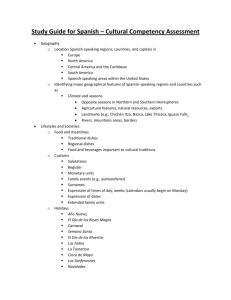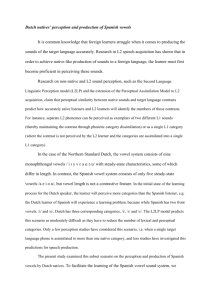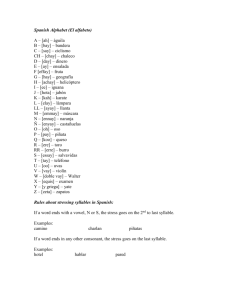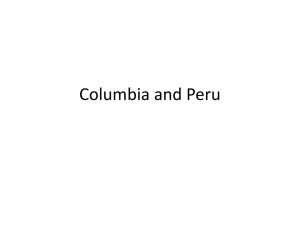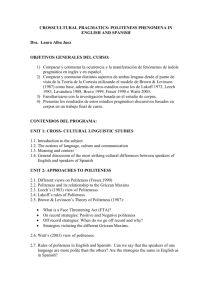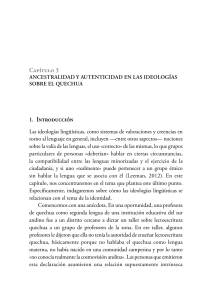argentina
advertisement
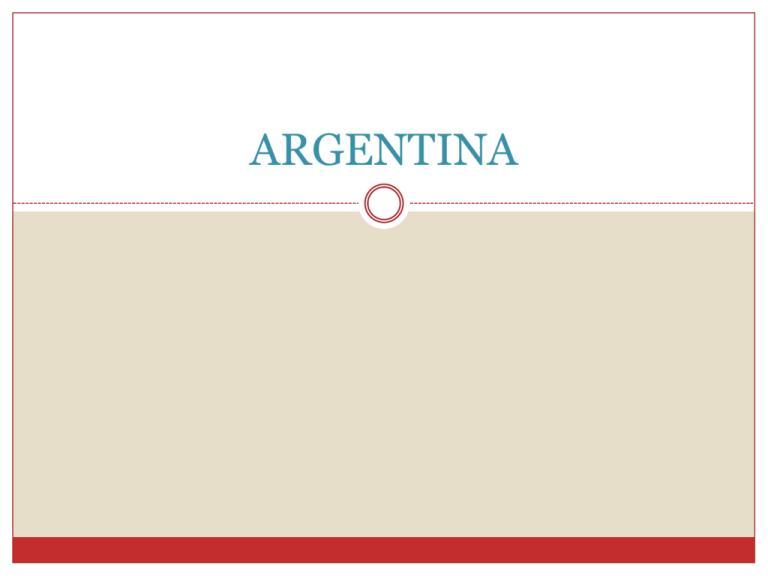
ARGENTINA Historical and Political background in Argentina • • • Extremo sureste de América del Sur Chile, Bolivia, Paraguay, Brasil y Uruguay 6 zonas dialectales distintas: La región costera Zona occidental Parte extrema noroccidental Nordeste La región central Unos cuantos enclaves El tema de la lengua estuvo presente durante muchos siglos en Argentina: Indígenas Llegaron a América hace unos 30.000 años, a Argentina hace 18.000 años mas o menos. Se afincaron en las montañas y en las llanuras. Antes de la colonización. El territorio estaba compuesto por varias culturas indígenas: Los Incas de Perú hablaban quechua. Los guaraníes en Paraguay. Los Araucanos y Mapuches. Siglo XVI el arribo de los conquistadores españoles Américo Vespucio en 1502 primer encuentro español. Tres modos de conquista: La región de Buenos Aires El noroeste Chile Imposición de la lengua española. La decadencia del imperio español. La inmigración africana. Las invasiones de Inglaterra en 1806 y 1807. La independencia Independencia 1816. Declaración de la independencia Con la Independencia política llego la cultural y lingüística. La Constitución Argentina en 1853. Aunque no estaba dictado la lengua española era y sigue siendo el idioma oficial. Muchas reformas en las siguientes décadas. La inmigración • Uno de los primeros inmigrantes fueron los españoles que a su vez trajeron la inmigración africana (esclavos). Durante la colonización muchos inmigrantes italianos y portugueses. Segunda mitad del siglo XIX y la primera mitad del siglo XX: el boom de la inmigración. La inmigración europea durante los años 1880-1914 60% de la populación de la Capital y casi el 30% de las provincias de Santa Fe, Córdoba y Buenos Aires inmigrantes. La mayoría italianos. Gente de muchos países. Otros idiomas o jergas El Cocoliche: era una variedad mixta del español e italiano, hablada por los inmigrantes italianos a finales del siglo XIX y a principios del siglo XX. El Lunfardo: una jerga utilizada en la región del Rio de la Plata. Aparte de estas jergas hoy en día en algunas regiones de Argentina hay idiomas cooficiales o se hablan como segundo idioma. El guaraní Quechua Gales Qom, Moqoit y Wichi. Specific Linguistic Features Within Argentina there are a number of regional and social variations; Argentina cannot be viewed as homogonous. Lipski: the variant that ‘porteños’ (residents of Buenos Aires) speak overshadows all others across the country. De Mirandi and De Battini identify at least 6 large dialects within Argentina. Regional Variations 1. Coastal region - extending from Buenos Aires, Entre Rios and Santa Fe to extreme southern Argentina. 2. Extreme western Argentina, inc. Mendoza and San Juan. 3. Extreme northwest portion including Tucumán. 4. The North East, including Corrientes and parts of the Chaco. 5. Central region, surrounding Cordoba, is a transitory zone. 6. A few small enclaves, such as the dialect of Santiago del Estero. Phonetic Traits Across Argentina Word final /n/ becomes alveolar E.g. estación, communicación... Loss of intervocalic /d/ words ending in '-ado', or the participle '-ido' The loss or weakening of /s/ at the end of a word /'xe-fe/ /'xe-fɛ/ jefe /'ka-sa/ /'ka-sa/ casa /'po-ko/ /'po-kɔ/ poco [lo-’pa-nɛ] los panes does not occur with vowels /i/ and /u/ Buenos Aires – use of aspiration is generally preferred over complete loss of /s/; loss carries a sociolinguistic stigma. Corrientes and Misiones – loss of /s/ is widespread and accepted, carries no stigma and is used by all social classes. Affricate /tʃ/ (ch) almost never loses its occlusive element to become fricative /ʃ/. If this were to occur, could create many homonyms resulting from prevalence of pronunciation of /y/ as /ʃ/ Morphological Variations Voseo – use of ‘vos’ in place of ‘tu’ for 2nd person singular Verbal endings are normally -ás, -és, -ís in the Northeast (Quechua influenced) use of -ís for 2nd person conjugation found mainly among uneducated rural speakers. Loísmo: Most of Argentina uses 'lo' as third person singular direct object. Some area specific variations Buenos Aires The /rr/ is pronounced as an alveolar trill Yeísmo - No differentiation exists between /λ/ and /y/ Zeísmo - pronunciation of /λ/ and /y/ as /ʃ/ (unvoiced) or /dz/ (voiced). E.g. Llaves [‘λa- βes] as [‘ʃa- βes] Northeast/Guaraní-influenced zone /r/ often dropped from the end of words, particularly infinitives. Misiones and Corrientes: /λ/ has been preserved, scattered presence of yeísmo Northwestern/Quechua-influenced zone Santiago del Estero: /y/ pronounced [y], but /λ/ is pronounced [dz] EL ESPAÑOL DE ARGENTINA LA IDEA DE PRESTIGIO PRESTIGIO Un dialecto de prestigio es un dialecto hablado por las personas mas prestigiosas, es decir, las que tienen más influencia dentro de la comunidad desde el punto de vista político, económico y social. El español hablado en Argentina se caracteriza por la huella que han dejado varios acontecimientos importantes en la historia de este país como la llegada de los conquistadores, los esclavos africanos, la inmigración tanto europea como de otras partes del continente americano PRESTIGIO Con la llegada de los conquistadores, la presencia indígena se hizo cada vez menos pronunciada aunque existe una influencia clara en los distintos dialectos hablados en Argentina. Por otro lado la presencia de los esclavos africanos en la zona no llegó del todo a influir de alguna manera ya que no hay ningún influjo lingüístico o cultural. PRESTIGIO No obstante, una vez conseguida la independencia política, la independencia cultura y lingüística no tardaron en llegar. Esto junto a la gran cantidad de inmigración debido a la Segunda Guerra Mundial hizo que lo llamado “argentino” se defina aun más como nación. Aunque fueron numerosos los inmigrantes europeos, fue la inmigración italiana la que ha ejercido el influjo lingüístico más notable en el español de Argentina. PRESTIGIO Como la parte donde la mayoría de los inmigrantes se asentaban era en Buenos Aires, es allí donde se empezaron a desarrollar rasgos tales como el yeísmo y el lleísmo o el rehilamiento, que son los principales rasgos por lo que se conoce el español de Argentina. Sin embargo a principios del siglo XIX cuando estos rasgos eran vistos como algo “provincial” tal como lo deja claro el viajero inglés Alexander Caldeleugh: PRESTIGIO “The Spanish spoken in Buenos Ayres is colonial, or rather provincial, anything but pure Castilian. Many of the words in most common use are sadly altered from their true pronunciation. Cavallo is pronounced Cavadjo, Calle Cadje, and yo jo.” También por otro lado, el yeismo era “un vicio de pronunciación propio de la plebe, de la chusma y no hubiera por tanto colocado como ejemplo de buen hablar a quien lo practicase.” PRESTIGIO No obstante, la independencia de la metrópoli no fue solo política sino también lingüística y cultural. Por tanto se funda la Academia de las Lenguas en América que hace que todo aquello que era considerado como vulgar o coloquial sea visto desde otra perspectiva, es decir, como una característica que contribuye a formar identidad de la nación. Chile: History, Origins & Politics of Chilean Spanish Brief history of Chile 1520: first European traveller arrived 1541: Pedro de Valdivia began conquering Chile (did it by splitting the country up into smaller sections) Colonisation affected the indigenous populations severely (disease, fighting to keep land) 1600s: mestizo ethnic group grew in number Language in Chile 9 living and 7 extinct languages Spanish is the official language 14 million Spanish speakers out of 16 million population Many native languages Mapudungun Quechua Rapa Nui (Easter Island) Huilliche Central Aymará Kawésqar Yámana Extinct languages Language changes due to mixed marriages Mapuche Languages Spoken mainly in Chile, but also in parts of Argentina Main family of native languages 2 branches: Huilliche and Mapudungun Some similarities to Quechua 200,000 fluent speakers in Chile Taught in schools in recent years Origins of Chilean Spanish Loan words from Native Languages Mainly Quechuan Vegetables Food Mapudungun influence Plants Animals Andalusian pronunciation Sometimes unintelligible to Standard Castilian speakers Linguistic Differences Chile can be divided up into four geographical areas: northern, central, south and the island of Chiloé. There is not much linguistic variation between the speakers in each area. However there is a considerable amount of linguistic variation in the Spanish spoken by different social classes. Morphological Differences Use of voseo with special verb forms. e.g. tenís instead of tienes, hablái instead of hablas 2 different ways of using voseo:- 1) Pronominal and verbal voseo e.g. vos venís 2) Verbal voseo, using the pronoun tú, e.g. tu hablái Dominance of the analytical future, i.e. ir a + infinitive Phonetic Characteristics Yeísmo The assimilation of the phonemes /ʎ/, spelled <ll>, and /j/, spelled <y>. E.g. cayó and calló are both pronounced [kaˈjo]. - Oroz (1966) notes that in some isolated rural areas of Southern Chile patches of lleísmo are still found Word-final and syllable-final /s/ is aspirated to [h] or lost entirely. e.g. los chilenos is [lɔh t͡ʃiˈleːnɔ] - amongst the educated urban classes the /s/ is aspirated, and total loss is stigmatised (apart from in phrase-final position) - in the extreme northeast along the border with Bolivia where some retention of sibilant [s] is found among Aymara speakers. The velar consonants /k/, /ɡ/, and /x/ are palatalised before front vowels. e.g. queso = [ˈceːso] guía = [ˈʝia] jinete = [çiˈn̪eːt̪e] Between vowels and word-finally, /d/ commonly elides or weakens. e.g. contado = [kon̪ˈt̪aːo] ciudad = [sjuˈð̞aː] Instability of unstressed vowels Predominant in informal speech In central Chile (el salar de Atacama) the unstressed vowels tend to close, especially in word-final positions. e.g. gato = [gá:ttu] despacho = [tihpáso] Word-final /n/ is alveolar. Velarisation is only found in the extreme northern area of the country which once belonged to Peru. Neutralisation of syllable-final liquids (/l/ and /r/) Oroz (1966) and Silva-Corvalán (1987) state that this is more frequent amongst the lower social classes, and the latter also notes that this trend is disappearing among the younger generations. /č / (=ch) and its frequent prepalatal articulation similar to [tˢ] as a distinguishing feature of Chilean Spanish. The voiceless postalveolar affricate /t͡ʃ/ is pronounced as a fricative [ʃ] by many the lower-class speakers e.g. Chile is pronounced [ˈʃiːle]) Chilean Spanish Any variety of Spanish spoken in most of Chile Has different vocabulary, grammar and pronunciation from standard Spanish 3 major influences: indigenous languages (Mapuche and Quechua), 'rioplatense' Spanish, and that of the European immigrants of the mid-1800s There are also great differences depending on social class and geography Originally similar to the Andalusian dialect More vocabulary derived from the Quechua language than from Nahuatl or Taíno as in standard Spanish Also words loaned from other neighbouring Amerindian languages (Mapudungan, Coa and Lunfardo) High use of slang and local expressions which makes it hard for foreigners to understand Number of phonetic features common to Chilean Spanish It is the particular combination of certain phonetic features that differentiate Chilean from other Spanish dialects One of the most obvious features of the Chilean accent is that final syllables and 's' sounds are usually aspirated The use of Voseo is common in Chile, with both Verbal and Pronominal voseo being widely used in the spoken language However, unlike in Argentina, is it not deemed acceptable as part of any written document except as reported speech. Voseo is usually considered bad linguistic form and tends to label the speaker as rude, unsophisticated or uneducated Chileans rarely use the voseo and tuteo forms in the second person familiar, as in many other Latin American countries A comparison of the conjugation of the Chilean voseo, the general voseo used in other Latin American countries, and the tuteo Due to certain factors Chilean Spanish is not seen to be as prestigious as other variations of the Spanish languages This is in part due to the high level of slang and local expressions used which not only makes it hard for non-native speakers to understand, but also makes it a less formal language As well as this a lot of the grammar and vocabulary used can not only be seen as unsophisticated but offensive and insulting if not used properly Finally as there is high variation in the language between different social classes and the rural/urban divide certain types can make the speaker seem less educated

